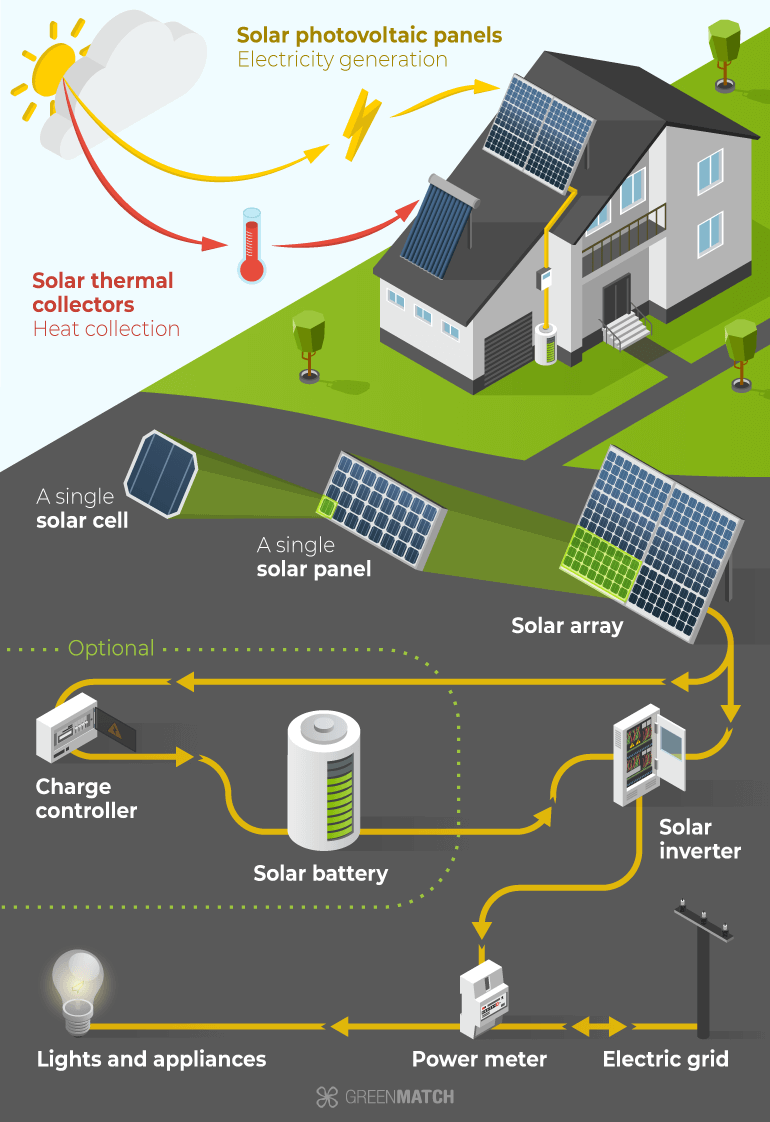When speaking about solar panels, it is important to distinguish between two main types:
Photovoltaic panels that produce electricity
Solar thermal panels that are used for heating purposes
Solar Panel System12345678
Solar photovoltaic panels
Photovoltaic (PV) systems are a commonly used solar panel system in the UK. Photovoltaic systems convert sunlight directly into electricity.
Solar cells are made of semiconductors, such as silicon, which absorb the sunlight and convert it into electricity.
Solar cells are connected electrically and packed together in a frame, commonly known as a solar panel. When you connect multiple solar panels together, they form a solar array. And, finally, when you add the cabling, brackets, inverter, and so forth, the entire system forms your solar panel system.
The electrical conductors are attached to positive and negative terminals, thus forming an electrical circuit. From there, the electrons can be captured in the form of an electric current (electricity). This current, together with the cell’s voltage (which is a result of its built-in electric field or fields), defines the power (or wattage) that the solar cell can produce, and is how solar panels convert sunlight into electricity.
Grid-connected vs. stand-alone PV systems
Grid-connected systems make use of the local utility grid to ensure you are never without electricity. If your residential solar panel system generates more electricity than your household requires in a day, this surplus energy can be exported back to the national grid. On the other hand, if you need more electricity than your solar panels have generated, the grid can supply this.
Stand-alone PV systems are not connected to the grid, but instead charge a solar battery system. These batteries store the electricity generated by your panels. To operate your appliances, the stored electricity from these batteries will be used. Stand-alone systems are used in areas that cannot be connected to a grid, and are typically more expensive than grid-connected systems because solar batteries are still quite costly.
Solar battery storage systems
Solar batteries store electricity generated by solar power and let you use it during the evenings when your solar panels are not generating electricity. You can make use of solar batteries whether you are connected to the grid or not.
Solar battery storage system costs are not low, ranging from £1,200 to £6,000, depending on the size and capacity. However, technological advancements are leading to new solutions year after year, and may likely lead to a reduction in solar battery prices.
Solar Thermal Collectors
Solar thermal panels use sunlight to heat up water that is stored in a cylinder, which can then be used for your home heating needs. Solar thermal panels are roof-mounted, just like electric solar PV panels, but look slightly different, as instead of cells they have multiple pipes that heat up water. A related technology is thermodynamic panels, which extract heat from the ambient air.
Both solar thermal and thermodynamic panels can be used for space heating, but most commonly they provide the domestic hot water (DHW) needs of households.

Already have an idea of what you’re looking for and don’t want to waste any more time? Simply click the button below to get up to 3 of the best solar panel quotes. It’s completely free and you’re under no obligation to accept any of the quotes you receive.
Post time: May-20-2023
